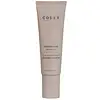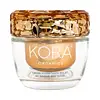What's inside
What's inside
 Key Ingredients
Key Ingredients

 Benefits
Benefits

 Concerns
Concerns

 Ingredients Side-by-side
Ingredients Side-by-side

Water
Skin ConditioningShea Butter Ethyl Esters
EmollientPropanediol
SolventLactobacillus Ferment
Skin ConditioningGlyceryl Stearate Citrate
EmollientGlycerin
HumectantCetearyl Alcohol
EmollientLactobacillus
Skin ConditioningGlyceryl Stearate
EmollientCarrageenan
Cocos Nucifera Fruit Extract
EmollientEntada Phaseoloides Bark/Seed Extract
Skin ConditioningSodium Benzoate
MaskingPhysalis Angulata Extract
Skin ProtectingCaprylic/Capric Triglyceride
MaskingXanthan Gum
EmulsifyingPotassium Sorbate
PreservativeCitric Acid
BufferingCitrus Limon Peel Oil
MaskingCitrus Aurantifolia Peel Oil
MaskingAstrocaryum Murumuru Seed Butter
EmollientHydrolyzed Sodium Hyaluronate
Skin ConditioningSodium Phytate
Cymbopogon Martini Motia Herb Oil
PerfumingBuddleja Globosa Leaf Extract
Skin ConditioningAristotelia Chilensis Leaf Extract
Skin ConditioningUgni Molinae Leaf Extract
Skin ConditioningTocopherol
AntioxidantLimonene
PerfumingCitral
PerfumingLinalool
PerfumingWater, Shea Butter Ethyl Esters, Propanediol, Lactobacillus Ferment, Glyceryl Stearate Citrate, Glycerin, Cetearyl Alcohol, Lactobacillus, Glyceryl Stearate, Carrageenan, Cocos Nucifera Fruit Extract, Entada Phaseoloides Bark/Seed Extract, Sodium Benzoate, Physalis Angulata Extract, Caprylic/Capric Triglyceride, Xanthan Gum, Potassium Sorbate, Citric Acid, Citrus Limon Peel Oil, Citrus Aurantifolia Peel Oil, Astrocaryum Murumuru Seed Butter, Hydrolyzed Sodium Hyaluronate, Sodium Phytate, Cymbopogon Martini Motia Herb Oil, Buddleja Globosa Leaf Extract, Aristotelia Chilensis Leaf Extract, Ugni Molinae Leaf Extract, Tocopherol, Limonene, Citral, Linalool
Aloe Barbadensis Leaf Juice
Skin ConditioningGlycerin
HumectantCoconut Alkanes
EmollientCetearyl Alcohol
EmollientPersea Gratissima Oil
Skin ConditioningRosa Canina Seed Oil
EmollientBalanites Roxburghii Seed Oil
Skin ConditioningWater
Skin ConditioningLactobacillus Ferment
Skin ConditioningCetearyl Olivate
Helianthus Annuus Seed Oil
EmollientSorbitan Olivate
EmulsifyingButyrospermum Parkii Butter
Skin ConditioningHippophae Rhamnoides Fruit Oil
Skin ProtectingPassiflora Edulis Seed Oil
EmollientCaprylic/Capric Triglyceride
MaskingOryza Sativa Extract
AbsorbentLactobacillus
Skin ConditioningAscorbyl Glucoside
AntioxidantCoco-Caprylate/Caprate
EmollientLactobacillus/Arundinaria Gigantea Leaf Ferment Filtrate
Skin ConditioningAstrocaryum Murumuru Seed Butter
EmollientGossypium Herbaceum Seed Oil
Skin ConditioningSaccharomyces Lysate Extract
HumectantBidens Pilosa Extract
HumectantCalendula Officinalis Flower Extract
MaskingCocos Nucifera Fruit Extract
EmollientPotassium Sorbate
PreservativeLavandula Angustifolia Oil
MaskingLinum Usitatissimum Seed Oil
PerfumingLactic Acid
BufferingPhospholipids
Skin ConditioningCitrus Limon Peel Oil
MaskingHydrolyzed Sodium Hyaluronate
Skin ConditioningMentha Piperita Oil
MaskingSclerotium Gum
Emulsion StabilisingPotassium Hydroxide
BufferingCurcuma Longa Root Extract
MaskingGlycyrrhiza Glabra Root Extract
BleachingMorinda Citrifolia Fruit Extract
Skin ConditioningYogurt Powder
Sodium Phytate
Cylindrotheca Fusiformis Extract
AntioxidantLeuconostoc/Radish Root Ferment Filtrate
AntimicrobialCananga Odorata Flower Oil
MaskingJuniperus Virginiana Oil
MaskingLeuconostoc Ferment Filtrate
AntimicrobialTocopherol
AntioxidantBisabolol
MaskingSoybean Peroxidase
AntioxidantSuperoxide Dismutase
AntioxidantAlcohol
AntimicrobialCitral
PerfumingGeraniol
PerfumingLimonene
PerfumingLinalool
PerfumingAloe Barbadensis Leaf Juice, Glycerin, Coconut Alkanes, Cetearyl Alcohol, Persea Gratissima Oil, Rosa Canina Seed Oil, Balanites Roxburghii Seed Oil, Water, Lactobacillus Ferment, Cetearyl Olivate, Helianthus Annuus Seed Oil, Sorbitan Olivate, Butyrospermum Parkii Butter, Hippophae Rhamnoides Fruit Oil, Passiflora Edulis Seed Oil, Caprylic/Capric Triglyceride, Oryza Sativa Extract, Lactobacillus, Ascorbyl Glucoside, Coco-Caprylate/Caprate, Lactobacillus/Arundinaria Gigantea Leaf Ferment Filtrate, Astrocaryum Murumuru Seed Butter, Gossypium Herbaceum Seed Oil, Saccharomyces Lysate Extract, Bidens Pilosa Extract, Calendula Officinalis Flower Extract, Cocos Nucifera Fruit Extract, Potassium Sorbate, Lavandula Angustifolia Oil, Linum Usitatissimum Seed Oil, Lactic Acid, Phospholipids, Citrus Limon Peel Oil, Hydrolyzed Sodium Hyaluronate, Mentha Piperita Oil, Sclerotium Gum, Potassium Hydroxide, Curcuma Longa Root Extract, Glycyrrhiza Glabra Root Extract, Morinda Citrifolia Fruit Extract, Yogurt Powder, Sodium Phytate, Cylindrotheca Fusiformis Extract, Leuconostoc/Radish Root Ferment Filtrate, Cananga Odorata Flower Oil, Juniperus Virginiana Oil, Leuconostoc Ferment Filtrate, Tocopherol, Bisabolol, Soybean Peroxidase, Superoxide Dismutase, Alcohol, Citral, Geraniol, Limonene, Linalool
 Reviews
Reviews

Ingredients Explained
These ingredients are found in both products.
Ingredients higher up in an ingredient list are typically present in a larger amount.
Astrocaryum Murumuru Seed Butter isn't fungal acne safe.
This ingredient is an emollient, solvent, and texture enhancer. It is considered a skin-softener by helping the skin prevent moisture loss.
It helps thicken a product's formula and makes it easier to spread by dissolving clumping compounds.
Caprylic Triglyceride is made by combining glycerin with coconut oil, forming a clear liquid.
While there is an assumption Caprylic Triglyceride can clog pores due to it being derived from coconut oil, there is no research supporting this.
Learn more about Caprylic/Capric TriglycerideCetearyl alcohol is a mixture of two fatty alcohols: cetyl alcohol and stearyl alcohol. It is mainly used as an emulsifier. Emulsifiers help prevent the separation of oils and products. Due to its composition, it can also be used to thicken a product or help create foam.
Cetearyl alcohol is an emollient. Emollients help soothe and hydrate the skin by trapping moisture.
Studies show Cetearyl alcohol is non-toxic and non-irritating. The FDA allows products labeled "alcohol-free" to have fatty alcohols.
This ingredient is usually derived from plant oils such as palm, vegetable, or coconut oils. There is debate on whether this ingredient will cause acne.
Due to the fatty acid base, this ingredient may not be Malassezia folliculitis safe.
Learn more about Cetearyl AlcoholCitral is a fragrance and used to add a lemon-like scent to products. It is both naturally found in plants and created synthetically. In plants, it is commonly occurring in lemon myrtle, lemongrass, lemon tea-tree, lemon verbena, and other citruses.
The EU mandates Citral be listed separately as a fragrance. It is a known allergen and may cause contact dermatitis. Citral can also used as a masking ingredient.
The term 'fragrance' is not regulated in many countries. In many cases, it is up to the brand to define this term. For instance, many brands choose to label themselves as "fragrance-free" because they are not using synthetic fragrances. However, their products may still contain ingredients such as essential oils that are considered a fragrance.
The term 'citral' is a collective term for two geometric isomers: geranial/Citral A and neral/Citral B.
Learn more about CitralCitrus Limon Peel Oil is created from the peels of the lemon. It is used to add a lemon-scent to products. Lemon peel oil also has antibacterial, antifungal, and antioxidant properties. However, it may also cause phototoxicity and sensitize skin.
Lemon peel oil contains limonene, a skin sensitizing ingredient. Another component is furanocoumarin, which induces phototoxicity in skin.
Furanocoumarins bind and destabilize your DNA to increase the rate of sunburn.
Most reputable companies will remove furanocoumarins from their formulations.
Learn more about Citrus Limon Peel OilCocos Nucifera Fruit Extract comes from the meat of the coconut fruit. It is an emollient and skin conditioner with antioxidant properties.
Coconut fruit is naturally rich in amino acids, sugars, and nutrients including Vitamin C and small amounts of vitamin B. Malic acid can also be found in coconut fruit extract.
Glycerin is already naturally found in your skin. It helps moisturize and protect your skin.
A study from 2016 found glycerin to be more effective as a humectant than AHAs and hyaluronic acid.
As a humectant, it helps the skin stay hydrated by pulling moisture to your skin. The low molecular weight of glycerin allows it to pull moisture into the deeper layers of your skin.
Hydrated skin improves your skin barrier; Your skin barrier helps protect against irritants and bacteria.
Glycerin has also been found to have antimicrobial and antiviral properties. Due to these properties, glycerin is often used in wound and burn treatments.
In cosmetics, glycerin is usually derived from plants such as soybean or palm. However, it can also be sourced from animals, such as tallow or animal fat.
This ingredient is organic, colorless, odorless, and non-toxic.
Glycerin is the name for this ingredient in American English. British English uses Glycerol/Glycerine.
Learn more about GlycerinThis ingredient is created by putting sodium hyaluronate through hydrolysis.
You might know this as 'mini' or 'ultra low-molecular weight' hyaluronic acid. The small molecule size means it is able to travel deeper in the skin.
According to studies, low molecular-weight hyaluronic acid can:
One study from 2011 found ultra-low weight HA to show pro-inflammatory properties. Another study from 2022 found it to downregulate UV-B induced inflammation.
Hydrolysis is a process of changing a molecule using water or enzymes.
This ingredient is water-soluble.
Learn more about Hydrolyzed Sodium HyaluronateLactobacillus is a type of bacteria with skin conditioning properties. This ingredient has antibacterial and antifungal properties (that's why we can eat fermented foods).
Learn more about the benefits of lactobacillus ferment here.
Fun Fact: Lactobacillus is used to create wine, yogurt, cheese, sauerkraut, pickles, beer, cider, kimchi, cocoa, kefir.
Learn more about LactobacillusLactobacillus Ferment is created by fermenting the Lactobacillus bacteria. It helps keep our skin's natural barrier and microbiome healthy.
Studies show lactobacillus ferment to be effective at repairing the skin barrier. Having a healthy skin barrier helps keep your skin healthy and hydrated. It also protects against bad bacteria.
As a probiotic/prebiotic/postbiotic, Lactobacillus ferment can help regular our natural biome. In fact, one study found a lack of diversity in our natural skin biome can trigger acne.
Learn more about Lactobacillus FermentLimonene is a fragrance that adds scent and taste to a formulation.
It's found in the peel oil of citrus fruits and other plants such as lavender and eucalyptus. The scent of limonene is generally described as "sweet citrus".
Limonene acts as an antioxidant, meaning it helps neutralize free radicals.
When exposed to air, oxidized limonene may sensitize the skin. Because of this, limonene is often avoided by people with sensitive skin.
The term 'fragrance' is not regulated in many countries. In many cases, it is up to the brand to define this term. For instance, many brands choose to label themselves as "fragrance-free" because they are not using synthetic fragrances. However, their products may still contain ingredients such as essential oils that are considered a fragrance.
Learn more about LimoneneLinalool is a fragrance and helps add scent to products. It's derived from common plants such as cinnamon, mint, citrus, and lavender.
Like Limonene, this ingredient oxidizes when exposed to air. Oxidized linalool can cause allergies and skin sensitivity.
This ingredient has a scent that is floral, spicy tropical, and citrus-like.
Learn more about LinaloolPotassium Sorbate is a preservative used to prevent yeast and mold in products. It is commonly found in both cosmetic and food products.
This ingredient comes from potassium salt derived from sorbic acid. Sorbic acid is a natural antibiotic and effective against fungus.
Both potassium sorbate and sorbic acid can be found in baked goods, cheeses, dried meats, dried fruit, ice cream, pickles, wine, yogurt, and more.
You'll often find this ingredient used with other preservatives.
Learn more about Potassium SorbateSodium Phytate is the synthetic salt form of phytic acid. Phytic acid is an antioxidant and can be found in plant seeds.
Sodium Phytate is a chelating agent. Chelating agents help prevent metals from binding to water. This helps stabilize the ingredients and the product.
Tocopherol (also known as Vitamin E) is a common antioxidant used to help protect the skin from free-radicals and strengthen the skin barrier. It's also fat soluble - this means our skin is great at absorbing it.
Vitamin E also helps keep your natural skin lipids healthy. Your lipid skin barrier naturally consists of lipids, ceramides, and fatty acids. Vitamin E offers extra protection for your skin’s lipid barrier, keeping your skin healthy and nourished.
Another benefit is a bit of UV protection. Vitamin E helps reduce the damage caused by UVB rays. (It should not replace your sunscreen). Combining it with Vitamin C can decrease sunburned cells and hyperpigmentation after UV exposure.
You might have noticed Vitamin E + C often paired together. This is because it is great at stabilizing Vitamin C. Using the two together helps increase the effectiveness of both ingredients.
There are often claims that Vitamin E can reduce/prevent scarring, but these claims haven't been confirmed by scientific research.
Learn more about TocopherolWater. It's the most common cosmetic ingredient of all. You'll usually see it at the top of ingredient lists, meaning that it makes up the largest part of the product.
So why is it so popular? Water most often acts as a solvent - this means that it helps dissolve other ingredients into the formulation.
You'll also recognize water as that liquid we all need to stay alive. If you see this, drink a glass of water. Stay hydrated!
Learn more about Water